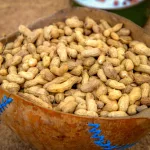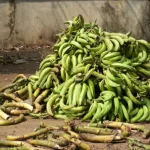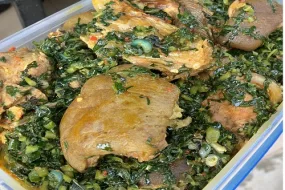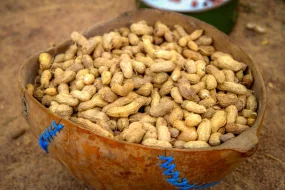What is Nigerian Millet?
Nigerian millet, also known as “Nigerian pearl millet,” is a type of cereal grain that is commonly grown and consumed in Nigeria and other West African countries. It’s a staple food in the region and is an important part of the local diet.
Millet is a versatile and nutritious grain that comes in various types, with pearl millet being one of the most common in Nigeria. It’s known for its drought tolerance, which makes it well-suited to the region’s climate. Here are some key points about Nigerian millet:

- Nutrition: Nigerian millet is a good source of essential nutrients such as carbohydrates, protein, dietary fiber, and various vitamins and minerals. It’s particularly rich in iron and magnesium.
Read, Also >>>>> A Comparative Analysis of Nigerian Sorghum, Health Benefits, Physical and Chemical Properties, and Delicious Recipes to Remember
- Culinary Uses: Millet is used in a variety of traditional Nigerian dishes. It’s often ground into flour to make a dough-like paste called “tuwo,” which is served with soups or stews. Millet can also be used to make porridge or cooked as a side dish, similar to rice or couscous.
- Versatility: Millet is not only used in savory dishes but also in sweet treats like millet pudding or as an ingredient in baking.
- Health Benefits: Millet is considered a healthy grain choice due to its nutritional profile. It’s gluten-free, making it suitable for people with gluten sensitivities, and it may help with managing blood sugar levels.
- Cultural Significance: In Nigeria, millet has cultural and social significance. It’s often served at important gatherings and celebrations.
- Farming: Pearl millet is well-suited to the Nigerian climate, as it can withstand dry conditions. It’s an important crop for local farmers, contributing to food security in the region.
So, in a nutshell, Nigerian millet is a type of cereal grain that plays a crucial role in the diets and cultures of Nigeria and other West African countries. It’s not only a dietary staple but also an integral part of the way of life in the region.
Comparative Analysis of Nigerian Millet
let’s do a comparative analysis of Nigerian millet, taking a closer look at how it stacks up against other popular grains like rice and wheat in terms of nutrition, cultivation, and culinary uses.
1. Nutrition:
- Nigerian Millet: Nigerian millet is known for its impressive nutritional content. It’s rich in essential nutrients like carbohydrates, protein, dietary fiber, iron, and magnesium. It is also gluten-free, making it suitable for those with gluten sensitivities.
- Rice: Rice is primarily a source of carbohydrates, and it’s a staple in many cultures. However, it is lower in protein and dietary fiber compared to millet. There are different types of rice, with brown rice being a more nutritious option due to its higher fiber content.
- Wheat: Wheat is also a carbohydrate-rich grain, and it’s a key ingredient in many baked goods. However, it is higher in gluten, which can be problematic for individuals with gluten intolerance or celiac disease. Whole wheat contains more fiber and nutrients compared to refined wheat products.
2. Culinary Uses:
- Nigerian Millet: In Nigeria, millet is used to make a variety of dishes. It’s commonly ground into flour to create “tuwo” (a dough-like paste) and served with soups or stews. Millet can also be used to make porridge and other traditional Nigerian delicacies.
- Rice: Rice is incredibly versatile and is used in a wide range of dishes worldwide, from pilaf to sushi. It can be served as a side dish, the main course, or in desserts.
- Wheat: Wheat is a key ingredient in bread, pasta, and pastries. It’s used to make a wide variety of baked goods, from baguettes to cakes and cookies.
3. Cultivation:
- Nigerian Millet: Millet is well-suited to the arid and semi-arid regions of Nigeria due to its drought tolerance. It’s a crucial crop for local farmers, contributing to food security in the region.
- Rice: Rice cultivation requires a lot of water and is often grown in flooded fields or paddies. It’s a major crop in many Asian countries, and its cultivation practices vary.
- Wheat: Wheat is grown in a wide range of climates but generally requires well-drained soils. It’s a major crop in countries like the United States, Canada, and Russia.
Nigerian millet stands out for its excellent nutritional content, adaptability to dry conditions, and cultural significance in Nigeria. It’s a staple grain that plays a vital role in local diets. Rice is versatile and widely consumed globally, while wheat is a primary source of gluten in many diets and is essential in the production of numerous wheat-based products. Each of these grains has its unique qualities and uses, making them important in their respective regions and cuisines.
Nutritional Properties of Nigerian Millet
This cereal grain offers a range of essential nutrients, making it a valuable dietary choice.
Nigerian millet nutrition Properties:
|
Quantity |
100g |
|
Calories |
325.045 kcl |
|
Fat |
3.365g |
|
Protein |
10.312g |
|
Carbohydrate |
59.5g |
1. Carbohydrates: Nigerian millet is a rich source of carbohydrates, providing sustained energy. It’s a staple in many Nigerian diets, offering a significant portion of daily caloric intake.
2. Protein: Millet contains a moderate amount of protein, making it an important protein source for those who rely on plant-based diets. It’s not as protein-dense as some legumes or animal products, but it still contributes to overall protein intake.
3. Dietary Fiber: Millet is relatively high in dietary fiber, especially compared to refined grains. This fiber aids in digestion and can help regulate blood sugar levels. It’s also beneficial for promoting a feeling of fullness, which can assist in weight management.
Read, Also >>>>> A Comparative Analysis of Nigerian Sorghum, Health Benefits, Physical and Chemical Properties, and Delicious Recipes to Remember
4. Vitamins: Millet contains various vitamins, including niacin (vitamin B3), folate (vitamin B9), and pantothenic acid (vitamin B5). These B vitamins are crucial for metabolism, cell health, and overall well-being.
5. Minerals: Millet is particularly rich in certain minerals, such as:
- Iron: An essential mineral for red blood cell production and overall health.
- Magnesium: Important for muscle and nerve function, bone health, and energy production.
- Phosphorus: Vital for strong bones and teeth, as well as various cellular processes.
- Potassium: Helps regulate blood pressure and fluid balance.
6. Antioxidants: Millet contains antioxidants that help protect the body’s cells from damage caused by free radicals. These antioxidants may have potential health benefits.
7. Gluten-Free: One notable advantage of millet is that it is naturally gluten-free, making it suitable for individuals with celiac disease or gluten sensitivity.
8. Low Fat Content: Millet is relatively low in fat, which can be advantageous for those looking to reduce their fat intake.
9. Low Glycemic Index: Millet has a lower glycemic index compared to some other grains, which means it has a slower impact on blood sugar levels, making it a good choice for people managing diabetes or looking to control blood sugar.
Nigerian millet is a nutritionally rich grain that provides carbohydrates, protein, dietary fiber, essential vitamins, and important minerals. Its gluten-free and low glycemic index properties make it a healthy choice, particularly for those with dietary restrictions or specific health concerns. This grain is not only a dietary staple but also contributes to overall well-being when included in a balanced diet.
Health Benefits of Nigerian Millet
Nigerian millet offers a range of health benefits due to its nutritional composition and unique properties. Here are some of the notable health benefits of consuming Nigerian millet:
- Rich Source of Nutrients: Nigerian millet is packed with essential nutrients such as carbohydrates, protein, dietary fiber, vitamins, and minerals. These nutrients are crucial for overall health and well-being.
- Digestive Health: The dietary fiber in millet promotes healthy digestion by preventing constipation and supporting regular bowel movements. It also aids in maintaining a healthy gut microbiome.
- Weight Management: The fiber content in millet can help you feel full and satisfied, which may contribute to weight management by reducing overeating and snacking.
- Gluten-Free Option: Millet is naturally gluten-free, making it an excellent choice for individuals with celiac disease or gluten sensitivity. It allows them to enjoy grains without the risk of adverse reactions.
- Balanced Blood Sugar: Millet has a lower glycemic index compared to some other grains. This means it can help regulate blood sugar levels and prevent sudden spikes and crashes, making it a good choice for people with diabetes.
- Heart Health: Millet is low in saturated fat and can help reduce cholesterol levels, promoting heart health. The magnesium content in millet supports cardiovascular function and helps regulate blood pressure.
- Bone Health: Millet is a good source of phosphorus, which is essential for strong bones and teeth. It also contains magnesium, which plays a role in bone health.
- Iron Absorption: The iron in millet, combined with vitamin C-rich foods, can enhance iron absorption in the body, helping to prevent anemia.
- Antioxidant Properties: Millet contains antioxidants, such as phenolic compounds, that can help protect the body’s cells from oxidative stress and reduce the risk of chronic diseases.
- Gluten-Free Whole Grain Option: Millet can be used to create gluten-free whole grain products, making it accessible to individuals who want to incorporate whole grains into their diet without gluten.
- Easy to Digest: Millet is considered one of the easiest grains to digest, making it suitable for people with sensitive digestive systems.
- Drought-Tolerant Crop: From an agricultural perspective, millet is a valuable crop because it can thrive in arid and semi-arid regions, helping to ensure food security in areas with water scarcity.
Nigerian millet offers a host of health benefits, from supporting digestive health to contributing to heart health and regulating blood sugar levels. Its gluten-free nature and nutritional richness make it a valuable addition to a balanced and diverse diet. Incorporating millet into your meals can be a healthy choice, and it provides a versatile alternative to other grains in various culinary applications.
Physical Properties of Nigerian Millet
These properties can be important for both agricultural purposes and culinary applications:
- Size and Shape: Nigerian millet grains are small, round, or oval-shaped, and have a somewhat flattened appearance. They are typically about 2-3 millimeters in diameter.
- Color: The color of Nigerian millet grains can vary, but they are commonly beige, yellow, or pale gray. The specific color may depend on the variety and growing conditions.
- Texture: The outer layer of millet grains has a thin, papery hull that needs to be removed during processing. The inner grain is smooth and glossy.
- Aroma: Nigerian millet has a mild, nutty aroma that becomes more pronounced when the grains are roasted.
- Taste: Millet has a mild, slightly sweet, and nutty flavor. It is often described as having a subtle, earthy taste.
- Density: Millet grains have a moderate density. They are not as dense as some other grains like wheat or barley, but they are not as light as rice, either.
- Water Absorption: Millet grains can absorb water when cooked, which causes them to swell and become tender. The exact water absorption rate may vary depending on cooking methods and the desired texture.
- Cooking Time: Millet cooks relatively quickly compared to some other grains. It usually takes around 15-20 minutes to cook once it’s brought to a boil.
- Cooked Texture: When cooked, Nigerian millet has a slightly chewy and fluffy texture. The grains remain separate and do not become mushy, making it a great choice for pilafs and side dishes.
- Grain Length: Millet grains are not as long as some other grains like rice. They are relatively short and round.
- Husk: The outer husk of millet grains needs to be removed during processing. This husk is inedible and is often mechanically removed to reveal the edible part of the grain.
- Culinary Versatility: Millet is versatile in the kitchen and can be used in a variety of dishes, from porridge to baked goods, and as a side dish in place of rice or couscous.
These physical properties of Nigerian millet make it a unique and versatile grain, suitable for a range of culinary applications. Its mild flavor and quick cooking time make it an excellent addition to various recipes, while its nutritional properties and adaptability to different growing conditions contribute to its importance in agriculture and food security.
Chemical Properties of Nigerian Millet
These properties provide insight into the composition and characteristics of this cereal grain:
-
Chemical Composition:
- Carbohydrates: Millet is predominantly composed of carbohydrates, which make up the bulk of its macronutrient content.
- Proteins: Millet contains proteins, which are essential for various bodily functions, including tissue repair and immune system support.
- Fats: While millet is relatively low in fat compared to some other grains, it does contain a small amount of fats, which contribute to its overall energy content.
- Dietary Fiber: Millet is a good source of dietary fiber, which aids in digestion and supports a healthy gastrointestinal system.
-
Starch Content:
- Millet contains a significant amount of starch, which serves as the primary source of energy in the grain.
-
Minerals:
- Iron: Millet is a notable source of iron, an essential mineral for red blood cell production and overall metabolic function.
- Magnesium: Millet is relatively rich in magnesium, a crucial mineral for muscle and nerve function, as well as bone health.
- Phosphorus: This mineral is essential for bone and teeth formation, as well as various cellular processes.
- Potassium: Millet contains potassium, which helps regulate blood pressure and maintain fluid balance.
-
Vitamins:
- Niacin (Vitamin B3): Niacin is important for metabolism, DNA repair, and overall cellular health.
- Folate (Vitamin B9): Folate is crucial for DNA synthesis, red blood cell formation, and neural tube development in fetuses.
- Pantothenic Acid (Vitamin B5): This vitamin is involved in energy production, hormone synthesis, and overall cellular function.
-
Antioxidants:
- Millet contains antioxidants, such as phenolic compounds, that help protect cells from damage caused by free radicals.
-
Phytic Acid:
- Like many grains, millet contains phytic acid, which can interfere with the absorption of certain minerals. However, processing techniques like soaking or sprouting can reduce phytic acid levels.
-
Protein Composition:
- Millet proteins consist of various amino acids, including essential amino acids that the body cannot produce on its own.
-
Lipids and Fatty Acids:
- Millet contains small amounts of lipids, which include different types of fatty acids, such as oleic acid, linoleic acid, and palmitic acid.
-
Moisture Content:
- The moisture content of millet can vary depending on factors such as storage conditions and processing methods.
-
pH Level:
- Millet typically has a slightly acidic to neutral pH, which can influence its culinary applications and interactions with other ingredients.
Macronutrients Data of Nigerian Millet
|
Weight |
100g |
|
Energy |
1520.36 Kj |
|
Calories |
325.045 kcl |
|
Fat |
3.365g |
|
Protein |
10.312g |
|
Carbohydrate |
59.5g |
|
Fiber |
7.8g |
|
Water |
8.90g |
Minerals Properties of Nigerian Millet
|
Weight |
100g |
|
Calcium |
13mg |
|
Iron (Fe) |
6.6mg |
|
Magnesium |
95mg |
|
Phosphorus (P) |
201mg |
|
Potassium (k) |
409mg |
|
Sodium (Na) |
17mg |
|
Zinc (Zn) |
2.97mg |
|
Copper (Cu) |
0.46mg |
|
Manganese |
0.273mg |
Understanding the chemical properties of Nigerian millet provides valuable insights into its nutritional content and potential health benefits. These properties are crucial for both agricultural practices and the development of nutritious food products.
Ways to Use Nigerian Millet
There are numerous ways to use Nigerian millet in your culinary endeavors. This versatile grain can be incorporated into a wide range of dishes, both savory and sweet. Here are some popular ways to use Nigerian millet:
- Pounded Tuwo: One of the most common uses of Nigerian millet is to create “tuwo,” a dough-like paste made by pounding millet flour with water. It is typically served as a side dish with soups and stews. Tuwo can be made from different types of millet, resulting in various textures and flavors.
- Millet Porridge: Millet can be cooked into a creamy and nutritious porridge by boiling it with water or milk. Add sweeteners like honey, sugar, or fruits for a delicious breakfast or dessert.
- Millet Couscous: Millet grains can be used as a substitute for traditional wheat couscous. Simply steam or cook millet grains and fluff them with a fork. Millet couscous pairs well with various sauces and stews.
- Millet Pilaf: Millet is an excellent base for savory pilaf dishes. Saute it with onions, garlic, and vegetables in a little oil or butter, add broth or water, and simmer until the grains are tender. You can customize your millet pilaf with herbs and spices.
- Millet Bread and Baked Goods: Millet flour can be used in baking to make gluten-free bread, muffins, pancakes, and other baked goods. It adds a nutty flavor and a pleasant texture to your creations.
- Millet Salad: Cooked millet makes a great addition to salads. Combine it with fresh vegetables, herbs, and a flavorful dressing for a nutritious and satisfying salad.
- Millet Soup: Millet can be added to soups to thicken them and provide extra nutrition. It’s a great way to make soups heartier and more filling.
- Millet Snacks: You can pop millet grains like popcorn, and they’ll puff up into crunchy, nutty snacks. These can be eaten as-is or used as a topping for salads or desserts.
- Millet Pudding: Create a delicious and healthy dessert by making millet pudding. Cook millet with milk, sweeteners, and flavorings like vanilla and cinnamon until it thickens. Serve it warm or chilled.
- Millet Smoothies: Ground millet can be added to smoothies to boost their nutritional content. It imparts a slightly nutty flavor and enhances the texture.
- Millet Side Dish: Cooked millet can be served as a side dish in place of rice or other grains. It pairs well with a variety of main dishes.
- Millet Breakfast Bowls: Use cooked millet as the base for breakfast bowls. Top it with yogurt, fresh fruits, nuts, and a drizzle of honey for a nutritious morning meal.
Remember that Nigerian millet is a versatile grain that can be adapted to various cuisines and dietary preferences. Its mild, nutty flavor and slightly chewy texture make it a delightful addition to many dishes, from breakfast to dinner and even snacks and desserts. Feel free to get creative and explore different ways to enjoy this nutritious grain in your meals.
Recipes Using Nigerian Millet
Here are two delicious recipes using Nigerian millet:
Recipe 1: Nigerian Millet Porridge
Ingredients:
- 1 cup Nigerian millet
- 4 cups water
- 1 cup milk (or a non-dairy alternative)
- 1/4 cup sugar (adjust to taste)
- 1/2 teaspoon vanilla extract
- Pinch of salt
- Optional toppings: sliced fruits, nuts, and a drizzle of honey
Instructions:
- Rinse the millet thoroughly under cold water to remove any impurities. Drain well.
- In a large saucepan, combine the millet, water, and a pinch of salt. Bring to a boil, then reduce the heat to low, cover, and simmer for about 15-20 minutes, or until the millet is tender and most of the liquid is absorbed.
- Stir in the milk, sugar, and vanilla extract. Continue to cook for another 5-7 minutes, stirring occasionally, until the porridge reaches your desired consistency.
- Taste and adjust the sweetness if needed.
- Serve the millet porridge warm in bowls. Top with your choice of sliced fruits, nuts, and a drizzle of honey.
Recipe 2: Millet and Vegetable Pilaf
Ingredients:
- 1 cup Nigerian millet
- 2 cups water
- 2 tablespoons oil (or butter)
- 1 small onion, finely chopped
- 2 cloves garlic, minced
- 1 cup mixed vegetables (e.g., carrots, peas, bell peppers), chopped
- 1 teaspoon cumin seeds
- 1/2 teaspoon ground turmeric
- 1 teaspoon ground coriander
- Salt to taste
- Fresh cilantro, for garnish
Instructions:
- Rinse the millet under cold water and drain well.
- In a large saucepan, heat the oil over medium heat. Add the cumin seeds and let them sizzle for a few seconds.
- Add the chopped onion and cook until translucent, about 3-4 minutes. Stir in the minced garlic and cook for an additional 30 seconds.
- Add the mixed vegetables, ground turmeric, and ground coriander. Cook for about 5 minutes, or until the vegetables are tender.
- Add the drained millet and stir to combine with the vegetables and spices.
- Pour in the water and bring the mixture to a boil. Reduce the heat to low, cover, and simmer for 15-20 minutes, or until the millet is cooked and the liquid is absorbed.
- Fluff the pilaf with a fork and season with salt to taste.
- Garnish with fresh cilantro and serve hot as a side dish.
Feel free to customize these recipes to your taste preferences by adding additional seasonings, vegetables, or proteins. Enjoy your nutritious and flavorful millet dishes!
Potential Side Effects and Things to Remember
1. Allergies: Some individuals may have allergies to millet, although this is relatively rare. If you experience symptoms such as itching, hives, swelling, or difficulty breathing after consuming millet, consult a healthcare professional.
2. Digestive Distress: Millet, like many whole grains, contains phytic acid, which can interfere with the absorption of minerals like calcium and iron. To mitigate this, you can soak or sprout millet before cooking. This can help reduce the phytic acid content and improve mineral absorption.
3. Portion Control: While millet is a healthy grain, consuming it in excessive amounts can contribute to an overconsumption of calories and carbohydrates. As with any food, it’s important to consume millet in moderation as part of a balanced diet.
4. Diabetic Considerations: Millet has a lower glycemic index compared to some grains, making it a better choice for those managing diabetes. However, individuals with diabetes should still monitor their blood sugar levels and be mindful of portion sizes when including millet in their meals.
5. Storage: Store millet in an airtight container in a cool, dry place to prevent spoilage or pest infestations.
6. Preparation and Cooking: Properly rinse millet before cooking to remove any impurities. Cooking times can vary depending on the type of millet and the desired texture, so follow cooking instructions for the specific dish you’re preparing.
7. Variety of Millet: There are different types of millet, each with its own flavor and texture. It’s essential to choose the variety that suits your culinary needs and preferences.
8. Balanced Diet: While millet offers various health benefits, it’s important to consume a variety of grains and foods to ensure a well-rounded and balanced diet.
As with any dietary changes, it’s advisable to consult with a healthcare professional or registered dietitian, especially if you have specific health concerns or dietary restrictions. Incorporating millet into your diet can be a nutritious and flavorful choice, but being mindful of your individual needs and preferences is key to enjoying its benefits while avoiding potential side effects.
In conclusion, Nigerian millet is a versatile and nutritious grain that plays a significant role in the diets and cultures of West Africa, particularly in Nigeria. It offers a range of health benefits, including being a good source of carbohydrates, protein, dietary fiber, vitamins, and minerals. Its versatility in the kitchen allows for various culinary applications, from making porridge and pilafs to using it in baking and as a side dish.
However, it’s important to be aware of potential side effects, such as allergies and digestive concerns, and to use millet in moderation as part of a balanced diet. It can be an excellent addition to your meals, but it’s essential to consider your individual dietary needs and preferences.
Incorporating Nigerian millet into your culinary repertoire can not only add variety to your meals but also introduce you to the rich flavors and traditions of West African cuisine. Whether you enjoy it as a hearty porridge, a flavorful pilaf, or a gluten-free alternative in baking, millet is a grain that offers both nourishment and cultural significance.
Read, Also >>>>> A Comparative Analysis of Nigerian Sorghum, Health Benefits, Physical and Chemical Properties, and Delicious Recipes to Remember
Reference
-
- Abdalla, A. A. , El Tinay, A. H. , Mohamed, B. E. , & Abdalla, A. H. (1998). Proximate composition, starch, phytate, and mineral contents of 10 pearl millet genotypes. Food Chemistry, 63, 243–246. 10.1016/S0308-8146(97)00228-8 – DOI
-
- Adeyemo, S. O. , Olayode, O. B. , & Odutuga, A. A. (1992). Biochemical analysis of germinated white maize (Zea mays). Nigerian Journal of Nutrition, 13, 14–18.
-
- Ali, M. A. M. , El Tinay, A. H. , & Abdalla, A. H. (2003). Effect of fermentation on the in vitro protein digestibility of pearl millet. Food Chemistry, 80, 51–54. 10.1016/S0308-8146(02)00234-0 – DOI
-
- Alozie, Y. E. , Iyam, M. A. , Lawal, O. , Udofia, U. , & Ani, I. F. (2009). Utilization of Bambara groundnut flour blends in bread production. Journal of Food Technology, 7, 111–114.
-
- Antony, U. , Sripriya, G. , & Chandra, T. S. (1996). Effect of fermentation on the primary nutrients in finger millet (Eleusine coracana). Journal of Agricultural and Food Chemistry, 44, 2616–2618.
-
- Association of Official Analytical Chemists (AOAC) (2005). Official Methods of Analysis of the Association of Analytical Chemists International, 18th ed Gathersuburg, MD: Official Methods; 2005.08
-
- Ayo, J. A., Ayo, V. A., Popoola, C., Omosebi, M., & Joseph, L. (2014). Production and evaluation of malted soybean‐acha composite flour bread and biscuit. African Journal Food Science and Technology, 5, 21–28.
-
- Badau, M. H. , Nkama, I. , & Jideani, I. A. (2005). Phytic acid content and hydrochloric acid extractability of minerals in pearl millet as affected by germination time and cultivar. Journal of Food Chemistry, 92, 425–435. 10.1016/j.foodchem.2004.08.006 – DOI
-
- Banerjee, S., Sanjay, K. R., Chethan, S., & Malleshi, N. G. (2012). Finger millet (Eleusine coracana) polyphenols: Investigation of their antioxidant capacity and antimicrobial activity. African Journal of Food Science, 6, 362–374.
-
- Brunner, J. H. (1984). Direct Spectrophotometer determination of saponin. Analytical Chemistry, 34, 1314–1326.
-
- Chandra, D. , Chandra, S. , & Pallavi, A. K. S. (2016). Review of Finger millet (Eleusine coracana (L.) Gaertn): A powerhouse of health benefiting nutrients. Food Science and Human Wellness, 5, 149–155. 10.1016/j.fshw.2016.05.004 – DOI
-
- Chandrasekara, A. , & Shahidi, F. (2011). Determination of antioxidant activity in free and hydrolyzed fractions of millet grains and characterization of their phenolic profiles by HPLC‐DAD‐MS. Food Science & Technology Bulletin Functional Foods, 3, 144–158.
-
- Chethan, S., & Malleshi, N. G. (2007). Finger millet polyphenols: Characterization and their nutraceutical potential. American Journal of Food Technology, 2, 582–592.
-
- Dhan, B. K. , & Gange, P. K. (2012). Effect of finger millet varieties on chemical characteristics of their malts. African Journal of Food Science, 6, 308–316.
-
- Egounlety, M., & Aworh, O. C. (2003). Effect of soaking, dehulling, cooking, and fermentation with Rhizopus oligosporus on the oligosaccharides, trypsin inhibitor, phytic acid, and tannins of soybean (Glycine max merr.), cowpea (Vigna unguiculata L. Walp) and groundbean (Macrotyloma geocarpa Harms). Journal of Food Engineering, 56, 249–254. 10.1016/S0260-8774(02)00262-5 – DOI
-
- Enujiugha, V. N. , Badejo, A. A. , Iyiola, S. O. , & Oluwamukomi, M. O. (2003). Effect of germination on the nutritional and functional properties of African oil bean (Pentaclethra macrophylla Benth) seed flour. Journal of Food, Agriculture and Environment, 1, 72–75.
-
- Gernah, D. I. , Ariahn, C. C. , & Ingbian, E. K. (2011). Effects of malting and lactic fermentation on some chemical and functional properties of maize (Zea mays). American Journal of Food Science Technology, 6, 404–412.
-
- Gunashree, B. S. , Selva, R. K. , Roobini, R. , & Venkateswaran, G. (2014). Nutrients and antinutrients of ragi and wheat as influenced by traditional processing. International Journal of Current Microbiology and Applied Science, 3, 720–736.
-
- Harborne, J. B. (1973). Phytochemical methods (pp. 49–188). London, UK: Chapman and Hall Ltd.
-
- Ijarotimi, O. S. (2012). Influence of germination and fermentation on chemical composition, protein quality, and physical properties of wheat flour (Triticum aestivum). Journal of Cereals and Oil Seeds, 3, 35–47.
-
- Ijarotimi, O. S., & Keshinro, O. O. (2011). Determination of amino acid, fatty acid, mineral, functional, and choking properties of germinated and fermented popcorn (Zea mays everta) flour. European Journal of Food Research and Review, 1, 102–122.
-
- Ikenebomah, K. , Kok, R. , & Ingram, J. M. (1986). Processing and fermentation of the African locust bean (Parkia filicoidea Welw.) to produce Dawa Dawa. Canadian Institute of Food Science Technology Journal, 17, 273–282.
-
- Issoufou, A. , Mahamadou, E. G. , & Guo‐Wei, Le (2013). Millets: Nutritional composition, some health benefits, and processing. Emirates Journal of Food and Agriculture, 25(7), 501–508.
-
- James, C. S. (1999). Analytical chemistry of foods (pp. 168–169, 2nd ed.). Frederick, MD: Aspen Publication Inc.
-
- Lansakaraa, L. H. M. P. R. , Liyanageb, R. , Pereraa, K. A. , Wijewardana, I. , Jayawardenaa, B. C. , & Vidanarachchi, J. K. (2016). Nutritional composition and health-related functional properties of Eleusine coracana (Finger Millet). Procedia Food Science, 6, 344–347. 10.1016/j.profoo.2016.02.069 – DOI
-
- Maillard, M. N. , & Berset, C. (1995). Evolution of antioxidant activity during kilning, the role of insoluble bound phenolic acids of barley and malt. Journal of Agricultural and Food Chemistry, 43, 1789–1793. 10.1021/jf00055a008 – DOI
-
- Makkar, A. O. S., & Goodchild, A. V. (1996). Qualification of tannins. A laboratory manual. International Centre of Agricultural Research in Dry Areas (ICRDA). Aleppo Syria, IV. 25 pp.
-
- McKeown, N. M., Meigs, J. B., Liu, S., Wilson, P. W. F., & Jacques, P. F. (2002). Whole grain intake is favorably associated with metabolic risk factors for type 2 diabetes and cardiovascular disease in the Framingham Offspring Study. American Journal of Clinical Nutrition, 76, 390–398. 10.1093/ajcn/76.2.390 – DOI – PubMed
-
- Mibithi‐Mwikya, S., Camp, J. V., Yiru, Y., & Huyghebaert, A. (2000). Nutrient and antinutrient changes in finger millet (Eleusine coracana) during sprouting. Lebensmittel Wissenchaft und Technologie, 33, 9–14. 10.1006/fstl.1999.0605 – DOI
-
- Middleton, E. Jr, Kandaswami, C., & Theoharides, T. C. (2000). The effect of plant flavonoids on mammalian cells: Implication for inflammation, heart disease cancer. Pharmacological Reviews, 52, 673–751. – PubMed
-
- National Research Council (1989). Recommended dietary allowance (10th ed.). Washington, DC: National Academy Press.
-
- Obiajunwa, E. I. , Adebiyi, F. M. , & Omode, P. E. (2005). Determination of essential mineral and trace elements in Nigerian sesame seeds, using TXPF Techniques. Pakistan Journal of Nutrition, 4, 393–395.
-
- Odusola, K. B. , Ilesanmi, F. F. , & Akinloye, O. A. (2013). Assessment of nutritional composition and antioxidant ability of pearl millet (Pennisetum glaucum). American Journal of Research Communication, 1, 262–272.
-
- Olagunju, A. I. , & Ifesan, B. O. T. (2013). Nutritional composition and acceptability of cookies made from wheat flour and germinated sesame (Sesamum indicum) flour blends. British Journal of Applied Science & Technology, 3, 702–713. 10.9734/BJAST – DOI
-
- Rupasinghe, H. P., Jackson, C. J., Poysa, V., Di‐Berardo, C., Bewley, J. D., & Jenkinson, J. (2003). Soyasapogenol A and B distribution in Soybean (Glycine max L. Merr.) in relation to seed physiology, genetic variability, and growing location. Journal of Agricultural and Food Chemistry, 51, 5888–5894. 10.1021/jf0343736 – DOI – PubMed
-
- Satish, L., Ceasar, S. A., & Ramesh, M. (2017). Improved Agrobacterium‐mediated transformation and direct plant regeneration in four cultivars of finger millet (Eleusine coracana (L.) Gaertn.). Plant Cell, Tissue, and Organ Cuture, 131, 547–565. 10.1007/s11240-017-1305-5 – DOI
-
- Shegal, S. A. , & Kwatra, S. (2006). Nutritional evaluation of pearl millet-based sponge cake. Journal of Food Science and Technology, 43, 312–313.
-
- Shimelis, E. A., & Rakshit, S. K. (2008). Effect of processing on antinutrients and in vitro protein digestibility of kidney bean (Phaseolus vulgaris L.) varieties grown in East Africa. Food Chemistry, 103, 161–172.
-
- Shweta, M. (2015). Pearl millet‐nutritional value and medicinal uses. International Journal of Advance Research, 1, 1–5.
-
- Singleton, V. L. , Orthofer, R. , & Lamuela‐Raventos, R. M. (1999). Analysis of total phenols and other oxidation substrates and antioxidants by means of Folin‐Ciocalteu Reagents. Methods in Enzymology, 299, 152–178. 10.1016/S0076-6879(99)99017-1 – DOI
-
- Sofidiya, M. O. , Odukayo, O. A. , Familoni, O. B. , & Inya‐Agha, S. I. (2006). Free radical scavenging activity of some Nigerian medical plant extracts. Pakistan Journal of Biological Sciences, 9, 1438–1441.
-
- Taylor, J. R. N. (2004). Millet: Pearl In Wrigley C., Corke H. & Walker C. E. (Eds.), Encyclopedia in grain science (pp. 253–261, Vol. 2). London, UK: Elsevier; 10.1016/B0-12-765490-9/00097-5 – DOI
-
- USDA (2005). Millet – Production, consumption, exports, and imports statistics. Washington, DC: United States Department of Agriculture.
-
- Varsha, V., Urooj, A., & Malleshi, N. G. (2009). Evaluation of antioxidant and antimicrobial properties of finger millet (Eleusine coracana) polyphenols. Food Chemistry, 114, 340–346.
-
- Veenashri, B. R., & Muralikrishna, G. (2011). In vitro antioxidant activity of xylo‐oligosaccharides derived from cereal and millet brans—A comparative study. Food Chemistry, 126, 1475–1481. 10.1016/j.foodchem.2010.11.163 – DOI
-
- Wheeler, E. L., & Ferrel, R. A. (1971). A method for phytic acid determination in wheat and wheat flour. Cereal Chemistry, 48, 312–320.
-
- Yoshimura, M. , Takahashin, H. , & Nakanishi, T. (1991). Role of sodium, calcium potassium, magnesium on blood pressure regulation and antihypertensive dietary therapy. Japanese Journal of Nutrition, 49, 53–62. 10.5264/eiyogakuzashi.49.53 – DOI
-
- Zakari, U. M. , Hassan, A. , & Abbo, E. S. (2010). Physicochemical and sensory properties of “Agidi” from pearl millet (Pennisetum glaucum) and Bambara groundnut (Vigna subterranean) flour blends. African Journal of Food Science, 4, 662–667.











